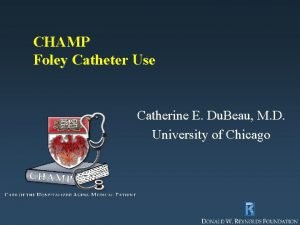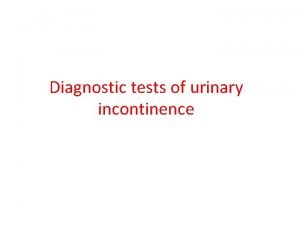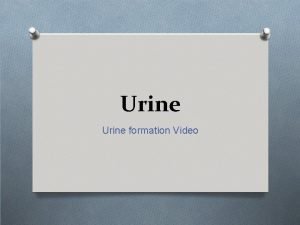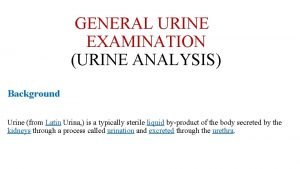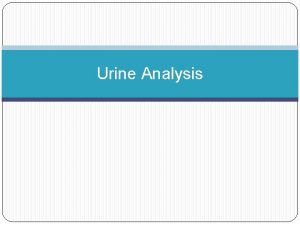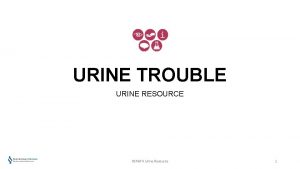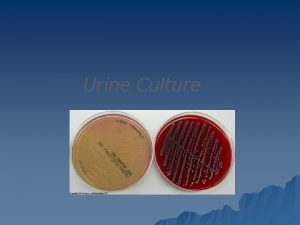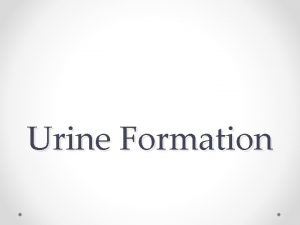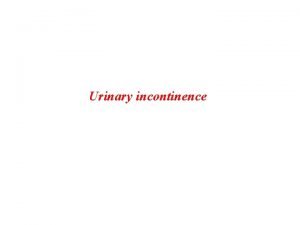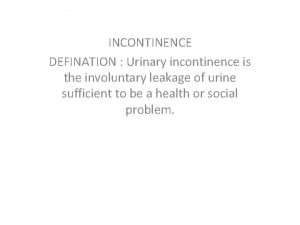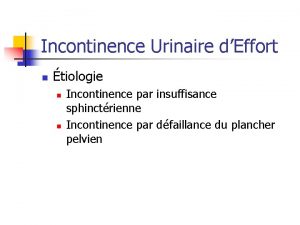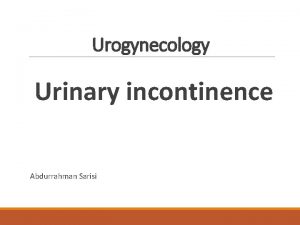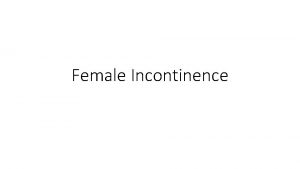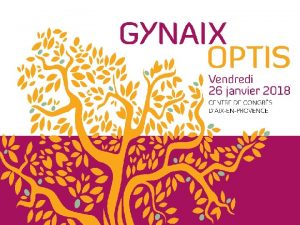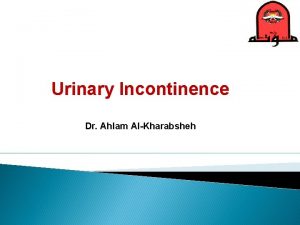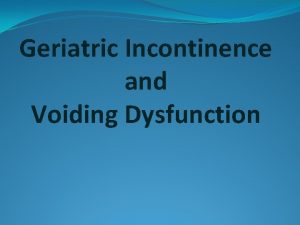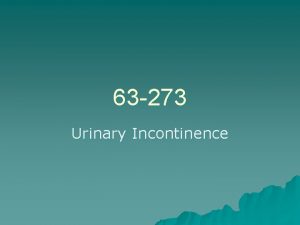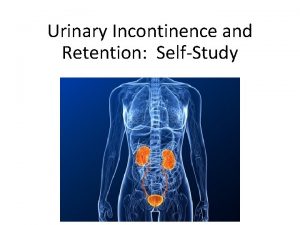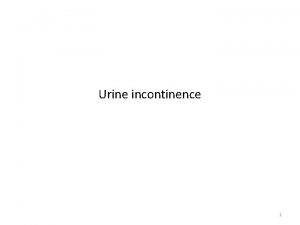INCONTINENCE OF URINE continence The term continence is

































- Slides: 33

INCONTINENCE OF URINE

continence • The term ‘continence’ is used to describe the normal ability of a person to store urine and faeces temporarily, with conscious control over the time and place of micturition and defecation. • Continence of urine and faeces is fundamental to the sociological, psychological and physical wellbeing of an individual • Infants do not have such control, but develop the neurological maturity and form the habits necessary, usually by 3 or 4 years of age

Incontinence • ‘Incontinence’ has been defined as the involuntary or inappropriate passing of urine or faeces, or both, that has an impact on social functioning or hygien. • This definition applies only after early childhood.

• society places demands that voiding occurs at a time and in a place that is acceptable to the majority. • If a person passes urine or faeces into clothing, in a bed or chair, on to the ground or into a receptacle not designated for the purpose the person is likely to be labelled as ‘incontinent’.

• Incontinence of urine or faeces is a symptom or a sign with a cause, not a condition or a specific disease. • It may be a temporary state associated with a transient cause (e. g. transient unconsciousness, infection, or drug sideeffects), or it may be persistent resulting from longer-lasting or even permanent causes (e. g. trauma in childbirth, stroke)

• it can lead to isolation, depression, loss of selfesteem, and ill health, for example infections

Prevention of continence problems • Repetitive coughing, smoking, frequent constipation, obesity, repeated heavy lifting and poorly controlled diabetes are just some of the factors that can lead to continence problems and over which an individual has some control • Following childbirth, it is important to regain prepregnancy strength of the pelvic floor muscles (PFMs) as far as humanly possible • As a prophylactic measure, every woman should be encouraged from a young age to make a regular habit of PFM contractions (Wall & Davidson 1992), and it is never too late to start!

• patients with hay fever, asthma, chronic chest conditions, back problems, stroke, multiple sclerosis, Parkinson’s disease, Alzheimer’s disease, hypertension and diabetes, those undergoing hip replacement, the elderly, the obese, those on crutches and those confined to a wheel chair are all at particular risk of developing bladder and bowel dysfunction

• The main groups of patients referred to the physiotherapist are those with storage symptoms resulting in urine leakage. • Incontinence of urine was defined as the involuntary loss of urine that is objectively demonstrable and is a social or hygienic problem

COMMON TYPES OF URINARY INCONTINENCE • • • Extraurethral incontinence Detrusor overactivity incontinence (urge) Urodynamic stress incontinence Nocturnal enuresis Giggle incontinence Functional incontinence

Extraurethral incontinence • Loss of urine through channels other than the urethra is called extraurethral incontinence. • This may be due to congenital abnormality (e. g. an aberrant ureter draining into the vault of the vagina). • Fistulae between the bladder or urethra and the vagina are most commonly the result of trauma at pelvic surgery such as hysterectomy, particularly where the pelvic anatomy has been distorted by disease such as endometriosis, infection or carcinoma. • In the Developing World, childbirth is still a major cause of trauma resulting in fistulae

Detrusor overactivity incontinence • The patient with detrusor overactivity complains of urge incontinence, which is involuntary leakage of urine accompanied by or immediately preceded by urgency, that is, a strong desire to void. • The amount lost is related to the intensity of the urgency and the amount of urine in the bladder.

• Detrusor overactivity is confirmed as a sign and observed at urodynamic assessment as spontaneous or provoked detrusor contractions during the filling phase

• Detrusor overactivity may be further qualified as neurogenic, where there is a relevant neurological condition, or as idiopathic, when there is no known cause.

ETIOLOGY • Local pathology such as infections, malignancies, interstitial cystitis or stones leads to hypersensitivity of the receptors in the bladder wall, and sometimes the urethra. • Thus, as the bladder fills, early and unwanted detrusor contractions are either produced spontaneously or provoked by activity. • Cystitis is the most common example of this manifestation. The patient responds by voiding frequently in an effort to reduce leakage episodes, and this behaviour may even continue after the cause has been removed.

• Neurogenic detrusor overactivity presents in a variety of forms. • For example, there may be detrusor contraction and urethral relaxation in the absence of any perceived sensory desire to void, owing to neurological impairment • It result from an uninhibited sacral micturition centre and associated reflex arc. It is seen in paraplegics, and the bladder empties incompletely and without proper conscious control

Managment • Removing the cause whenever possible and explaining the problem to the patient. • Pharmacotherapy • Teaching deferment techniques using repeated voluntary PFM contractions • Bladder training to regain confidence and to improve the ability to hold reasonable volumes of urine • Continuous electrical stimulation with a pulse duration of 500 s at 5– 10 Hz applied daily for 20– 30 minutes

Urodynamic stress incontinence

• The symptom. The patient complains of incontinence on stress, that is, when the intraabdominal pressure is raised by exertion or effort (e. g. sneezing, coughing or walking)

• The sign. An involuntary spurt, dribble or droplet of urine is observed to leave the urethra immediately on an increase in intra-abdominal pressure (e. g. when coughing). • This test should be performed with a reasonable amount of urine in the bladder, and may need to be conducted standing up, rather than lying down. • The patient may also be able to demonstrate how a particular activity such as jumping produces a leak

• The condition. Urodynamic stress incontinence (USI) is the name coined to denote the condition in which there is • involuntary loss of urine , in the absence of a detrusor contraction, the intravesical pressure (pressure in the bladder) exceeds the maximum urethral pressure. • Essentially the detrusor activity is normal but the urethral closure mechanism is incompetent. There may be associated bladder neck hypermobility.

CAUSES • Prolapse of the bladder and urethra, due to damage to supporting structures or associated with uterine descent, • prolapse, particularly if it substantially involves the anterior wall of the vagina • Atrophy associated with reduced oestrogen and ageing attacks the elastic and adhesive factors of the urethral wall. • weakness of the pelvic floor

Weakness of PFMs • trauma to muscle or adjacent tissues (e. g. surgery or childbirth) • damage to the nerve supply to the sphincter or levator ani muscle (e. g. from surgery, stretching or tearing at childbirth) • weakness from underuse (the patient may sit around all day, perhaps suffering from depression) • stretching from overuse (e. g. repeated coughing, straining at the stool because of constipation, heavy lifting or obesity)

Management of USI • Identifying the precipitating factors • The treatment of chest infections or respiratory allergies, stopping of smoking, reduction in obesity, help with a heavy dependent relative, relief of constipation, treatment for depression, encouragement to activity and other general health- and continence promoting advice may be enough to relieve symptoms • encouraged to make a daily habit of PFMCs • Where the PFMs are very weak or the patient is unable to produce a PFMC, biofeedback with or without electrical stimulation should be offer • Where there is considerable prolapse with obvious bladder neck descent, surgery will probably be required

Nocturnal enuresis

• Nocturnal enuresis is urinary incontinence during sleep, or ‘bed wetting’ at an age when a person could be expected to be dry – usually agreed to be the developmental age of 5 years • It must be differentiated from waking with urgency and failing to reach the toilet in time (i. e. detrusor overactivity incontinence) • It is often associated with daytime leakage

MANAGMENTS • It may be necessary to change diet to reduce caffeine intake, such as cola drinks and chocolate. • Reward charts and scheduled awakening may be tried. • Where it is thought that the child sleeps too deeply to be aware of the desire to void, various alarm systems can be used. • Antidiuretic drugs may be prescribed, for example desmopressin, which can be administered as a nasal spray or orally (Glazener & Evans 2003). • Specialised bedding products may reduce the need for changes in the night, and it is never a waste of time to teach PFM contractions, which may have some inhibitory effect on the detrusor muscle

Giggle incontinence

• It is thought that giggle incontinence is caused by detrusor overactivity induced by laughter • treatment is as for detrusor overactivity; • in severe cases this may include pharmocotherapy. • Time is well spent explaining exactly why the leakage occurs and teaching PFM exercise and deferment techniques. • Not only should the girl practise PFM exercise regularly to build up strength and endurance but she should be encouraged to develop the habit of contracting these muscles before and while giggling. • Continence-promoting advice should include fluid intake and bowel habits

Functional incontinence

• there is involuntary loss of urine resulting from a deficit in ability to perform toileting functions secondary to physical or mental limitations.


 Acfi answer appraisal pack
Acfi answer appraisal pack Uui definition
Uui definition Bulbocavernosus reflex
Bulbocavernosus reflex Coital incontinence
Coital incontinence Dari hasil tes ternyata urin pak yudha mengandung glukosa
Dari hasil tes ternyata urin pak yudha mengandung glukosa The cf py/o means
The cf py/o means Term to term rule
Term to term rule Long term memory vs short term memory
Long term memory vs short term memory Difference between long term and short term liabilities
Difference between long term and short term liabilities Good short term goals
Good short term goals How to find the nth term of a sequence
How to find the nth term of a sequence Accounting for serial bonds
Accounting for serial bonds Short medium and long term planning in education
Short medium and long term planning in education Short term financial management
Short term financial management Short term and long term human resource planning
Short term and long term human resource planning Term to term rule example
Term to term rule example Minterm and maxterm
Minterm and maxterm In my understanding
In my understanding Term-to-term rule
Term-to-term rule Chó sói
Chó sói Thiếu nhi thế giới liên hoan
Thiếu nhi thế giới liên hoan Tia chieu sa te
Tia chieu sa te điện thế nghỉ
điện thế nghỉ Một số thể thơ truyền thống
Một số thể thơ truyền thống Thế nào là hệ số cao nhất
Thế nào là hệ số cao nhất Trời xanh đây là của chúng ta thể thơ
Trời xanh đây là của chúng ta thể thơ Slidetodoc
Slidetodoc Hệ hô hấp
Hệ hô hấp Thế nào là số nguyên tố
Thế nào là số nguyên tố đặc điểm cơ thể của người tối cổ
đặc điểm cơ thể của người tối cổ Các châu lục và đại dương trên thế giới
Các châu lục và đại dương trên thế giới Tư thế worms-breton
Tư thế worms-breton ưu thế lai là gì
ưu thế lai là gì Tư thế ngồi viết
Tư thế ngồi viết


